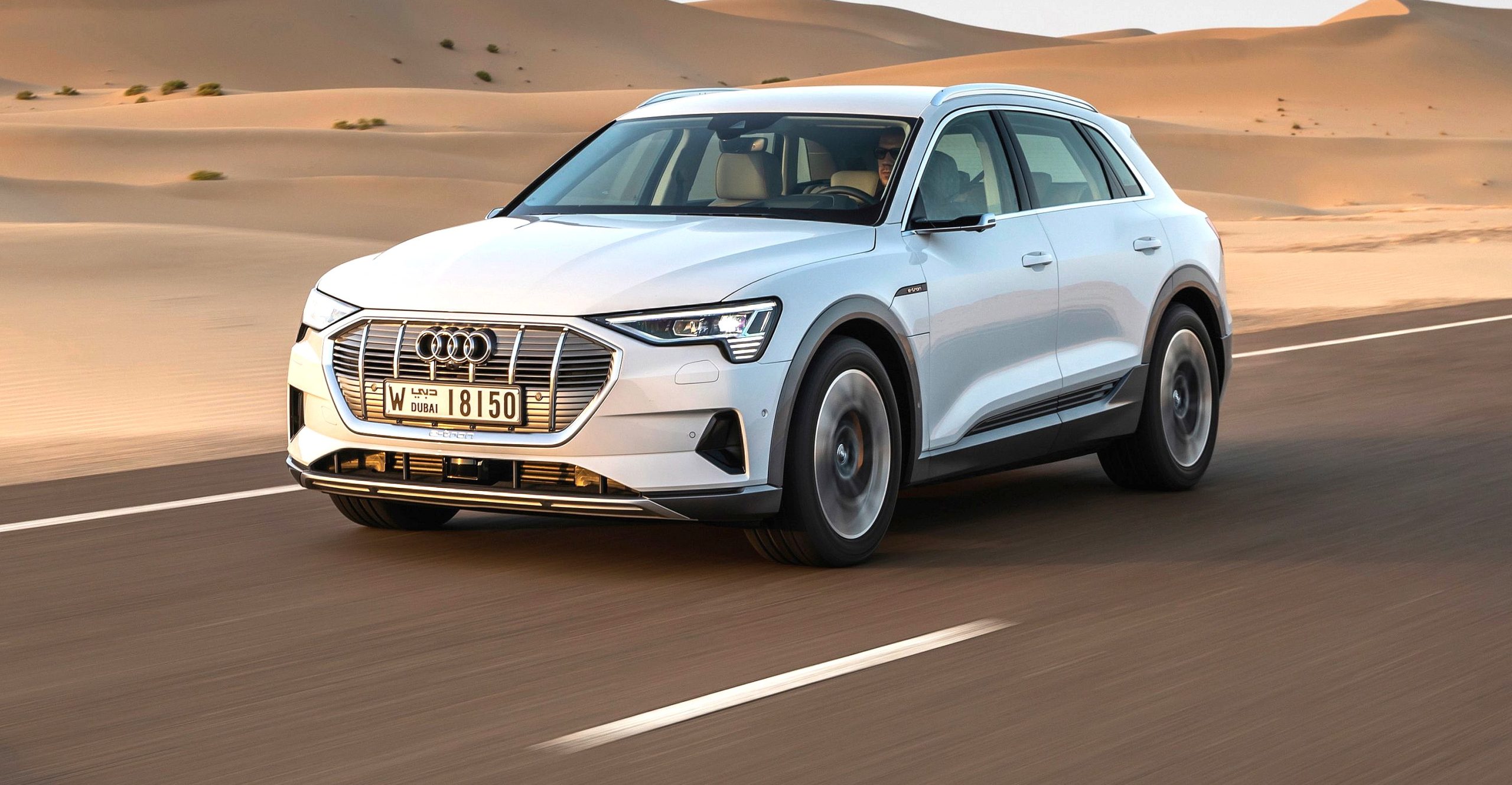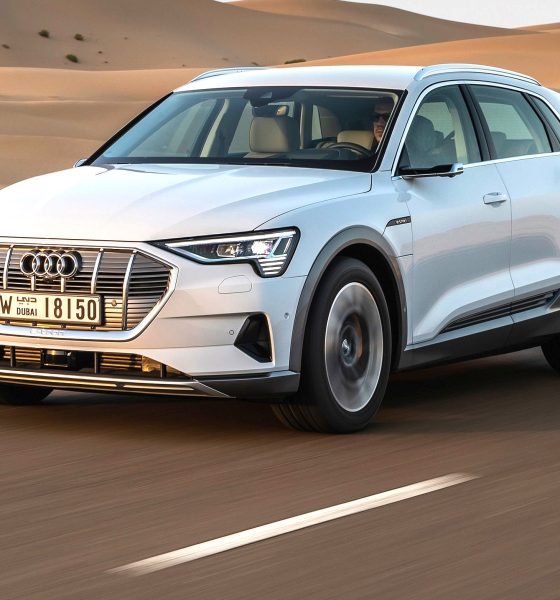

News
Audi e-tron customers face more delivery delays, fines for canceled orders: report
As Audi starts delivering the e-tron all-electric SUV to customers, some reservation holders in Norway are complaining over extra delays in vehicle deliveries. One e-tron reservation holder even reported to Norwegian media that he was faced with a fine when he attempted to cancel his order for the vehicle.
Around 7,000 Norwegians placed reservations for the Audi e-tron since it was unveiled last year, but the deliveries of the all-electric SUV have been slower than expected. Amidst large orders for the vehicle and limited supplies of components such as batteries, Audi has faced challenges in the SUV’s rollout. Roar Lauvstad, a reservation holder for the e-tron, noted in a statement to news publication Tek.no that he had been informed of a possible six-month extra wait time for his order, despite deliveries of the SUV already beginning in the country.
Audi has rolled out a “Fast Track” system for Norway, which allows immediate delivery of the e-tron provided that reservation holders order a specific variant of the SUV. The starting price of the e-tron in the country is listed at around NOK 650,000 (around $74,000), but the “Fast Track” variant, the Audi e-tron 55 Advanced Plus, costs around NOK 840,000 (around $95,000). This, according to Lauvstad, forces reservation holders like himself to either select a more expensive version or wait several more months for the actual variant he selected.
Unfortunately, Lauvstad met an unexpected roadblock when he attempted to cancel his e-tron order. According to the reservation holder, he was informed that be would be facing a fine amounting to 8% of his order’s purchase price. “I could break the contract (or) buy a Fast Track car, but I couldn’t just break the contract. They would then have 8% (around $6,800) of the purchase price of around NOK 750,000 (around $85,000) for breach of contract. So now I’m still waiting,” he said (translated using Google Translate).
Audi’s delays with the rollout of the e-tron come amidst reports that the German automaker is running into issues with the supply of the SUV’s batteries, which are sourced from LG Chem, the same company that provides cells for other EVs like the Porsche Taycan and the Jaguar I-PACE. Citing unnamed sources, The Brussels Times reported last month stated that Audi is only operating the e-tron’s production facilities 6 hours a day. Audi’s plant in Györ, Hungary, which produces the e-tron’s electric motors, are reportedly seeing delays as well, partly due to the effects of a workers’ strike earlier this year.
Audi’s growing pains with the ramp of the e-tron echo some of the struggles that Tesla faced when it was starting the production of its vehicles. The Tesla Model X was noteworthy for being delayed due to its design and over-the-top tech, and the Model 3 ramp was aptly described by Elon Musk as production hell. Based on what Audi is experiencing with the e-tron, it appears that even experienced automakers are bound to go through some pains as they learn how to build competitive electric cars.
One thing that appears to be different between Tesla and Audi is how the companies manage requests for cancelation among reservation holders. While Audi seems to have included a penalty in the fine print of its e-tron reservations, Tesla has allowed order cancellations that are practically worry-free. As noted by Elon Musk, orders for Tesla’s electric cars are still fully refundable even after seven days or 1,000 miles.

Elon Musk
Elon Musk’s X will start using a Tesla-like software update strategy
The initiative seems designed to accelerate updates to the social media platform, while maintaining maximum transparency.

Elon Musk’s social media platform X will adopt a Tesla-esque approach to software updates for its algorithm.
The initiative seems designed to accelerate updates to the social media platform, while maintaining maximum transparency.
X’s updates to its updates
As per Musk in a post on X, the social media company will be making a new algorithm to determine what organic and advertising posts are recommended to users. These updates would then be repeated every four weeks.
“We will make the new 𝕏 algorithm, including all code used to determine what organic and advertising posts are recommended to users, open source in 7 days. This will be repeated every 4 weeks, with comprehensive developer notes, to help you understand what changed,” Musk wrote in his post.
The initiative somewhat mirrors Tesla’s over-the-air update model, where vehicle software is regularly refined and pushed to users with detailed release notes. This should allow users to better understand the details of X’s every update and foster a healthy feedback loop for the social media platform.
xAI and X
X, formerly Twitter, has been acquired by Elon Musk’s artificial intelligence startup, xAI last year. Since then, xAI has seen a rapid rise in valuation. Following the company’s the company’s upsized $20 billion Series E funding round, estimates now suggest that xAI is worth tens about $230 to $235 billion. That’s several times larger than Tesla when Elon Musk received his controversial 2018 CEO Performance Award.
As per xAI, the Series E funding round attracted a diverse group of investors, including Valor Equity Partners, Stepstone Group, Fidelity Management & Research Company, Qatar Investment Authority, MGX, and Baron Capital Group, among others. Strategic partners NVIDIA and Cisco Investments also continued support for building the world’s largest GPU clusters.
News
Tesla FSD Supervised wins MotorTrend’s Best Driver Assistance Award
The decision marks a notable reversal for the publication from prior years, with judges citing major real-world improvements that pushed Tesla’s latest FSD software ahead of every competing ADAS system.

Tesla’s Full Self-Driving (Supervised) system has been named the best driver-assistance technology on the market, earning top honors at the 2026 MotorTrend Best Tech Awards.
The decision marks a notable reversal for the publication from prior years, with judges citing major real-world improvements that pushed Tesla’s latest FSD software ahead of every competing ADAS system. And it wasn’t even close.
MotorTrend reverses course
MotorTrend awarded Tesla FSD (Supervised) its 2026 Best Tech Driver Assistance title after extensive testing of the latest v14 software. The publication acknowledged that it had previously criticized earlier versions of FSD for erratic behavior and near-miss incidents, ultimately favoring rivals such as GM’s Super Cruise in earlier evaluations.
According to MotorTrend, the newest iteration of FSD resolved many of those shortcomings. Testers said v14 showed far smoother behavior in complex urban scenarios, including unprotected left turns, traffic circles, emergency vehicles, and dense city streets. While the system still requires constant driver supervision, judges concluded that no other advanced driver-assistance system currently matches its breadth of capability.
Unlike rival systems that rely on combinations of cameras, radar, lidar, and mapped highways, Tesla’s FSD operates using a camera-only approach and is capable of driving on city streets, rural roads, and freeways. MotorTrend stated that pure utility, the ability to handle nearly all road types, ultimately separated FSD from competitors like Ford BlueCruise, GM Super Cruise, and BMW’s Highway Assistant.
High cost and high capability
MotorTrend also addressed FSD’s pricing, which remains significantly higher than rival systems. Tesla currently charges $8,000 for a one-time purchase or $99 per month for a subscription, compared with far lower upfront and subscription costs from other automakers. The publication noted that the premium is justified given FSD’s unmatched scope and continuous software evolution.
Safety remained a central focus of the evaluation. While testers reported collision-free operation over thousands of miles, they noted ongoing concerns around FSD’s configurable driving modes, including options that allow aggressive driving and speeds beyond posted limits. MotorTrend emphasized that, like all Level 2 systems, FSD still depends on a fully attentive human driver at all times.
Despite those caveats, the publication concluded that Tesla’s rapid software progress fundamentally reshaped the competitive landscape. For drivers seeking the most capable hands-on driver-assistance system available today, MotorTrend concluded Tesla FSD (Supervised) now stands alone at the top.
News
Elon Musk’s Grokipedia surges to 5.6M articles, almost 79% of English Wikipedia
The explosive growth marks a major milestone for the AI-powered online encyclopedia, which was launched by Elon Musk’s xAI just months ago.

Elon Musk’s Grokipedia has grown to an impressive 5,615,201 articles as of today, closing in on 79% of the English Wikipedia’s current total of 7,119,376 articles.
The explosive growth marks a major milestone for the AI-powered online encyclopedia, which was launched by Elon Musk’s xAI just months ago. Needless to say, it would only be a matter of time before Grokipedia exceeds English Wikipedia in sheer volume.
Grokipedia’s rapid growth
xAI’s vision for Grokipedia emphasizes neutrality, while Grok’s reasoning capabilities allow for fast drafting and fact-checking. When Elon Musk announced the initiative in late September 2025, he noted that Grokipedia would be an improvement to Wikipedia because it would be designed to avoid bias.
At the time, Musk noted that Grokipedia “is a necessary step towards the xAI goal of understanding the Universe.”
Grokipedia was launched in late October, and while xAI was careful to list it only as Version 0.1 at the time, the online encyclopedia immediately earned praise. Wikipedia co-founder Larry Sanger highlighted the project’s innovative approach, noting how it leverages AI to fill knowledge gaps and enable rapid updates. Netizens also observed how Grokipedia tends to present articles in a more objective manner compared to Wikipedia, which is edited by humans.
Elon Musk’s ambitious plans
With 5,615,201 total articles, Grokipedia has now grown to almost 79% of English Wikipedia’s article base. This is incredibly quick, though Grokipedia remains text-only for now. xAI, for its part, has now updated the online encyclopedia’s iteration to v0.2.
Elon Musk has shared bold ideas for Grokipedia, including sending a record of the entire knowledge base to space as part of xAI’s mission to preserve and expand human understanding. At some point, Musk stated that Grokipedia will be renamed to Encyclopedia Galactica, and it will be sent to the cosmos.
“When Grokipedia is good enough (long way to go), we will change the name to Encyclopedia Galactica. It will be an open source distillation of all knowledge, including audio, images and video. Join xAI to help build the sci-fi version of the Library of Alexandria!” Musk wrote, adding in a later post that “Copies will be etched in stone and sent to the Moon, Mars and beyond. This time, it will not be lost.”








